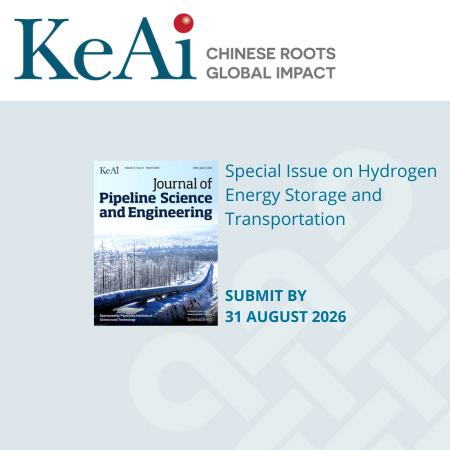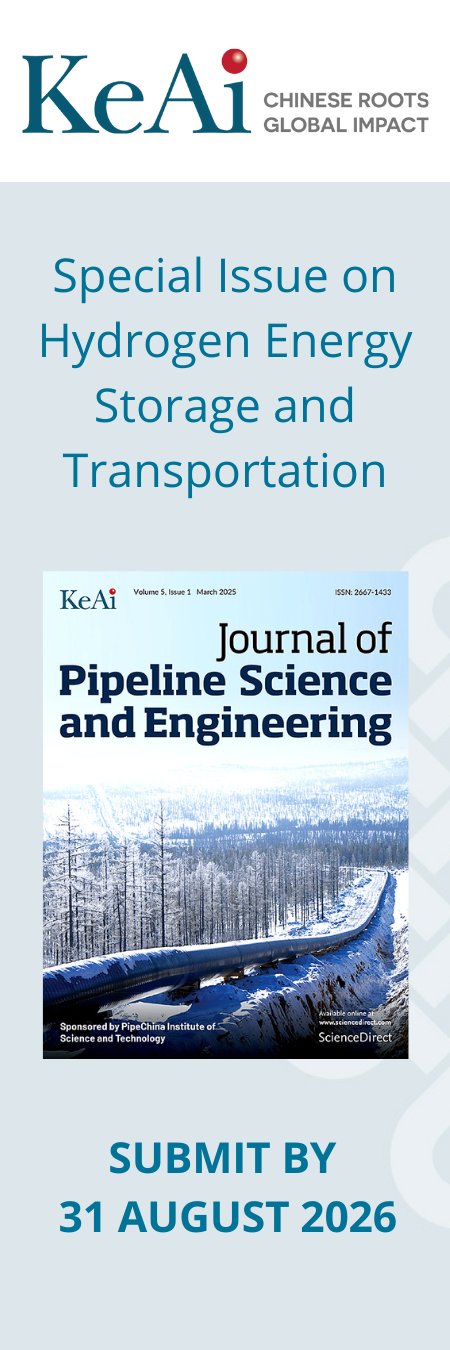Methanol-Oil Co-transportation System: Strategic Facility Planning for Multiproduct Pipelines to Maximize Benefits
Available online 8 December 2025
Shifts in energy consumption patterns and the adoption of cleaner fuels have left multiproduct pipelines operating below their design capacity. Leveraging these existing multiproduct pipelines for methanol-oil...
Adaptive Pressure Wave for Blockage Localization via Variational Mode Decomposition and Time-Delay Correction
Available online 4 December 2025
Deep-sea oil and gas pipelines are prone to hydrate blockages under high-pressure and low-temperature conditions, posing significant threats to transportation safety and efficiency. Traditional acoustic...
Study of model adaptability and thermophysical property variations for ammonia and its mixtures
Available online 1 December 2025
•Model adaptability of ammonia and its mixtures’ thermal properties was evaluated.•Variations of thermophysical parameters for ammonia and its mixtures were analyzed.•Impurities significantly affect...
Understanding Detection Success of Belowground Natural Gas Leaks in Urban Environments through Controlled Release Experiments
Available online 1 December 2025
•Urban environment significantly reduces natural gas pipeline leak detection success.•Higher leak rates improve the probability of detection by up to 37 pp (percentage points) compared to lower leak...
Pipeline Unidirectional Guided Wave Generation Based on a Hybrid Piezoelectric Transducer Ring and Wave-Packet Modification
Available online 29 November 2025
For pipeline inspection, unidirectional guided waves are needed to concentrate energy in a single propagation direction while suppressing backward-traveling components. Conventional time-delay methods...
Research on LLM-based assessment methods for international standards' intelligent contribution to oil and gas pipelines
Available online 27 November 2025
•Innovation point name•A Method for Evaluating Intelligent Contribution to International Oil and Gas Pipeline Standards Based on Large Language Models•Innovation point content•First, different large...
Prediction of electrical insulation performance for oil and gas pipeline insulating joints based on multi-parameter fusion
Available online 24 November 2025
•First model integrating CP, geometric & environmental parameters for accuracy•XGBoost achieves 98.49% accuracy, surpassing traditional methods•Early detection of minor failures prevents severe corrosion...
A numerical simulation method for CO2 leakage considering non-equilibrium phase transition
Available online 20 November 2025
Carbon dioxide (CO2) exhibits high compressibility and complex phase-transition behavior. In the event of a leakage, CO2 undergoes rapid expansion and intricate phase transitions, resulting in a composite...
Accelerate the development of a new energy system with “substance-energy network” as the foundation
Available online 17 November 2025
Analytical solutions of stress field around lined rock caverns with yieldable concrete lining subject to high internal pressure and non-hydrostatic geo-stress field
Available online 16 November 2025
This study develops an analytical framework for the stress field around Lined Rock Caverns (LRCs) for compressed air energy storage, subjected to high internal pressure and non-hydrostatic geo-stress....
A critical review on corrosion challenges and prospects in supercritical offshore CO2 pipelines
Available online 12 November 2025
CO2 sequestration in deep-sea sediments is one of the most promising methods for reducing anthropogenic CO2, and offshore pipelines are crucial for CO2 transportation in CCUS projects. This work provides...
Integrating Modified Pipe–Soil Interaction and Damage Mechanics to Assess Girth Weld Fracture under Permanent Ground Movement
Available online 11 November 2025
Pipe girth weld (PGW) represent the most vulnerable structural joints in long-distance pipelines and are highly susceptible to fracture under Permanent Ground Movement (PGM). Conventional pipe–soil...
Characterizing Properties of Pipeline Girth Welds: A Novel Testing Protocol and Validation
Available online 3 November 2025
Accurate, region-specific mechanical properties of pipeline girth welded joints are fundamental for structural safety design and integrity assessment. This study focuses on X80 pipeline girth welded...
Effect of Soils Reinforced with PET Waste in Reducing Loads Transferred to Buried Pipeline
Available online 31 October 2025
Buried pipelines need to limit the surface loads transferred on them in order to ensure trouble-free operation throughout their service life. The objective of this study was to evaluate the the efficacy...
Improved guided-wave acoustic defect detection and localization in pipes under varying temperature conditions using deep learning
Available online 30 October 2025
Early defect detection in pipelines is critical across industries, particularly in the oil and gas sector, where failures result in significant maintenance costs and operational disruptions. Acoustic...
A numerical study on flow and heat transfer characteristics of the LNG storage tank feed pipeline
Available online 28 October 2025
As a low-carbon fuel, liquefied natural gas (LNG) requires strict temperature control during transportation. Direct injection into pipelines at ambient temperature induces significant thermal stress,...
Deep learning-based intelligent path planning system design for subsea pipeline laying
Available online 28 October 2025
Subsea pipeline route planning is one of the core challenges in marine engineering. Traditional methods, which rely on manual expertise and static algorithms, struggle to adapt to complex and dynamic...
A Physics-informed Reinforcement Learning Approach for Multiproduct Pipeline Pump Scheduling Optimization
Available online 28 October 2025
Pipeline transportation is the primary method for transporting multiproducts, necessitating an effective pump scheduling strategy to ensure safe operation and economic advantages. The working conditions...
Modeling of damage-crack evolution for subsea pipelines subject to corrosion-fatigue
Available online 27 October 2025
Subsea pipelines approaching design life demonstrate structural degradation as progressive corrosion and fatigue cracking. This deterioration elevates the potential leak while reducing operation integrity...
Three-Dimensional Imaging Method for Pipeline Based on Magnetic Gradient Detection
Available online 27 October 2025
Accurate detection of buried pipelines is vital for underground resource development and maintenance safety. This paper proposes a 3D imaging method based on magnetic gradient sensing to reduce operational...
Pipeline Transportation Strategy and Key Technological Breakthroughs for High-Quality Development of Hydrogen Energy Industry under the Dual Carbon Goals
Available online 25 October 2025
China’s hydrogen scale-up hinges on resolving midstream bottlenecks that move volumes from resource-rich northern and western basins to demand-dense coastal corridors. A structured synthesis of policy,...
Precise identification of pipeline surface defects utilizing ultrasonic guided wave technology and data-driven algorithmic approaches
Available online 25 October 2025
Long-range ultrasonic guided waves (UGW) represent a critical approach for pipeline defect detection. However, the intricate propagation characteristics of high-frequency UGW signals, combined with...
Assessment of Releases from Hydrogen and Hydrogen-Blended Natural Gas Pipelines: A Review
Available online 20 October 2025
With the global shift towards sustainable energy, hydrogen and hydrogen-blended natural gas (HBNG) pipelines are becoming integral components of low-carbon energy infrastructures. Nevertheless, the...
Research on the Subdivision of Oil Delivery Districts and Adjustment of Oil Depots Locations by the Method of Equidistant Subdivision and Weight Proportion
Available online 17 October 2025
•Path optimization using spherical area improves accuracy over planar methods.•Integrated model cuts petrochemical delivery costs and boosts efficiency.•Algorithm suits energy distribution and multi-level...
A Data-Driven Risk Assessment Framework for Ammonia Pipelines: Insights from 232 Accident Cases (1970–2023)
Available online 17 October 2025
Ammonia pipelines are gaining renewed attention as key enablers of hydrogen energy systems, offering a practical solution to hydrogen transport and storage. However, current safety standards remain...


